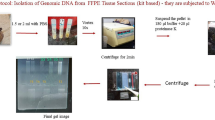Abstract
Changes in alternative splicing have been linked to cancer development. We hypothesized that changes occurring in tumor tissue can also be detected in the peripheral blood of cancer patients leading to discovery of blood biomarkers of breast cancer. Alternative splicing profiles of 94 genes were examined in cancerous breast tissue. Discriminating splice variants were analyzed in the peripheral blood of early stage (BCI/II) (stage I–II; n = 26), neoadjuvant receiving locally advanced breast cancer patients (LABC) (stage IIb–IIIa, b; n = 10) and healthy volunteers (n = 26) using qRT-PCR analysis. Changes in marker expression during neoadjuvant therapy were analyzed at 15 timepoints. High expression of REST-N50, the alternatively spliced variant of REST, was detected in the blood of LABC patients but not in BCI/II and healthy controls (p = 0.0032 and p = 0.0029, respectively). Expression levels of DOPEY1v2, the alternative splice variant of DOPEY1, in the blood could differentiate cancer from healthy controls (p = 0.024) and discriminate between patient groups (BCI/II vs LABC, p = 0.002). Positive response to neoadjuvant therapy of REST-N50-positive LABC patients correlated with a decrease in REST-N50 levels (p < 0.0001). Assessment of REST-N50 and DOPEY1v2 may prove useful in diagnostic blood tests of breast cancer. REST-N50 shows a high potential as a blood biomarker for evaluating the effectiveness of therapy in the neoadjuvant setting.




Similar content being viewed by others
References
Herschkowitz JI, Simin K, Weigman VJ, Mikaelian I, Usary J, Hu Z, et al. Identification of conserved gene expression features between murine mammary carcinoma models and human breast tumors. Genome Biol. 2007;8:R76. doi:10.1186/gb-2007-8-5-r76.
Hu Z, Fan C, Oh DS, Marron JS, He X, Qaqish BF, et al. The molecular portraits of breast tumors are conserved across microarray platforms. BMC Genomics. 2006;7:96. doi:10.1186/1471-2164-7-96.
Perou CM, Sørlie T, Eisen MB, van de Rijn M, Jeffrey SS, Rees CA, et al. Molecular portraits of human breast tumours. Nature. 2000;406:747–52. doi:10.1038/35021093.
Sharma P, Sahni NS, Tibshirani R, Skaane P, Urdal P, Berghagen H, et al. Early detection of breast cancer based on gene-expression patterns in peripheral blood cells. Breast Cancer Res. 2005;7:R634–44. doi:10.1186/bcr1203.
Aarøe J, Lindahl T, Dumeaux V, Saebø S, Tobin D, Hagen N, et al. Gene expression profiling of peripheral blood cells for early detection of breast cancer. Breast Cancer Res. 2010;12:R7. doi:10.1186/bcr2472.
Tobin D, Karlsson M, Hagen N, Børresen-Dale A, Sharma P. Use of the blood based, 96-assay set for breast cancer detection. Poster presented at the 21st meeting of the EACR 26–29 June 2010 Oslo, Norway. 2010.
Venables JP. Aberrant and alternative splicing in cancer. Cancer Res. 2004;64:7647–54. doi:10.1158/0008-5472.CAN-04-1910.
Faustino NA, Cooper TA. Pre-mRNA splicing and human disease. Genes Dev. 2003;17:419–37. doi:10.1101/gad.1048803.
Venables JP, Klinck R, Bramard A, Inkel L, Dufresne-Martin G, Koh C, et al. Identification of alternative splicing markers for breast cancer. Cancer Res. 2008;68:9525–31. doi:10.1158/0008-5472.CAN-08-1769.
Livak KJ, Schmittgen TD. Analysis of relative gene expression data using real-time quantitative PCR and the 2(−delta delta C(T)) method. Methods. 2001;25:402–8. doi:10.1006/meth.2001.1262.
Wagoner MP, Gunsalus KTW, Schoenike B, Richardson AL, Friedl A, Roopra A. The transcription factor REST is lost in aggressive breast cancer. PLoS Genet. 2010;6:e1000979. doi:10.1371/journal.pgen.1000979.
Coulson JM, Edgson JL, Woll PJ, Quinn JP. A splice variant of the neuron-restrictive silencer factor repressor is expressed in small cell lung cancer: a potential role in derepression of neuroendocrine genes and a useful clinical marker. Cancer Res. 2000;60:1840–4.
Palm K, Metsis M, Timmusk T. Neuron-specific splicing of zinc finger transcription factor REST/NRSF/XBR is frequent in neuroblastomas and conserved in human, mouse and rat. Brain Res Mol Brain Res. 1999;72:30–9.
Su AI, Wiltshire T, Batalov S, Lapp H, Ching KA, Block D, et al. A gene atlas of the mouse and human protein-encoding transcriptomes. Proc Natl Acad Sci U S A. 2004;101:6062–7. doi:10.1073/pnas.0400782101.
Pachmann K, Dengler R, Lobodasch K, Fröhlich F, Kroll T, Rengsberger M, et al. An increase in cell number at completion of therapy may develop as an indicator of early relapse: quantification of circulating epithelial tumor cells (CETC) for monitoring of adjuvant therapy in breast cancer. J Cancer Res Clin Oncol. 2008;134:59–65. doi:10.1007/s00432-007-0248-3.
Liew C, Ma J, Tang H, Zheng R, Dempsey AA. The peripheral blood transcriptome dynamically reflects system wide biology: a potential diagnostic tool. J Lab Clin Med. 2006;147:126–32. doi:10.1016/j.lab.2005.10.005.
Kowalewska M, Chechlińska M, Markowicz S, Kober P, Nowak R. The relevance of RT-PCR detection of disseminated tumour cells is hampered by the expression of markers regarded as tumour-specific in activated lymphocytes. Eur J Cancer. 2006;42:2671–4. doi:10.1016/j.ejca.2006.05.036.
Gunsalus KTW, Wagoner MP, Meyer K, Potter WB, Schoenike B, Kim S, et al. Induction of the RNA regulator LIN28A is required for the growth and pathogenesis of RESTless breast tumors. Cancer Res. 2012;72:3207–16. doi:10.1158/0008-5472.CAN-11-1639.
Acknowledgments
This study was supported by Protobios’s grants from the Enterprise of Estonia and baseline financing from the Estonian Ministry of Education and Research. We are grateful to Dr. Jõeste and NEMC for the tissue samples. We thank K.J.M. Rand for the work with in silico database, primer design, and cloning; Dr. Pruunsild and Prof. Timmusk for the resources provided; and K. Taal and H. Verev for the technical help in sample handling.
Conflicts of interest
None.
Author information
Authors and Affiliations
Corresponding author
Additional information
Ave Kris Lend and Anna Kazantseva contributed equally to this work.
Electronic supplementary material
Below is the link to the electronic supplementary material.
ESM 1
(PDF 107 kb)
Rights and permissions
About this article
Cite this article
Lend, A.K., Kazantseva, A., Kivil, A. et al. Diagnostic significance of alternative splice variants of REST and DOPEY1 in the peripheral blood of patients with breast cancer. Tumor Biol. 36, 2473–2480 (2015). https://doi.org/10.1007/s13277-014-2860-6
Received:
Accepted:
Published:
Issue Date:
DOI: https://doi.org/10.1007/s13277-014-2860-6




